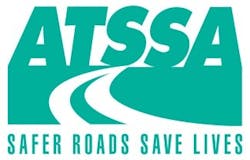By: Emily Freehling
Roadway infrastructure is often talked about in terms of dollars and cents, but the reality is that every road project puts human lives on the line.
When the American Traffic Safety Services Association (ATSSA) incorporated in 1970, it was the product of an experience no one in the industry ever wants to have—losing a worker on a jobsite.
“The owner of a barricade company had to go tell a family that their father wasn’t coming home that night because he was killed in a work zone,” ATSSA Vice President of Member Services Donna Clark said. “About seven barricade company owners met in the basement of one of their homes and said, ‘I never want to have to go tell another family their loved one isn’t coming home.’”
From the beginning, the main tool ATSSA used to combat work zone fatalities was education, in the form of focused training for the individuals who would work on road projects.
It is easy to look at training as a nicety, or something your company does when time allows, but over the years, DOTs around the U.S., as well as the Federal Highway Administration (FHWA), have come to realize that effective training for workers in the roadway infrastructure industry saves lives.
Juan M. Morales, an ATSSA Master Trainer and owner of Florida-based J.M. Morales & Associates, said a major turning point came in the early 2000s when many state DOTs began requiring training or certification for contractors and individuals working on roadways. As early states like Florida and Virginia began requiring training, other states were spurred to do likewise, resulting in more and more trained workers.
He pointed to statistics that show a peak in work zone fatalities in 2002, with approximately 1,300 people killed in work zones. The number steadily declined for years, reaching a low point of 576 fatalities in 2010, according to the National Work Zone Safety Information Clearinghouse. While the number has ebbed and flowed in recent years, it has not come close to the 2002 peak.
“It could be other reasons, but I personally think that the training deserves credit for a lot of the drop in fatalities,” Morales said.
Clark said that having the DOTs recognize the importance of training and require it for companies working on their roads has been critical to expanding the distribution of roadway safety training, as well as the development of new courses to educate more workers.
“Once the requirement for training was written into the specifications, you couldn’t get out on the road unless you had been trained,” Clark said. “From there, it really took off.”
Since Clark started her career at ATSSA in 1998, the organization, which is based in Fredericksburg, Va., has grown its training offerings from two classes to an entire catalog of courses in a variety of subjects, including temporary traffic control, flagger training, pavement marking, pedestrian safety, work zone safety for law enforcement, incident response and guardrail installation.
As a trade group representing the traffic safety industry, ATSSA recruits from a network of experienced subject-matter experts to write, update, and teach courses.
Morales said part of what sets ATSSA training apart is the fact that it tailors its materials to best reach its intended audience.
“We avoid long and convoluted PowerPoint slides,” he said. “A lot of these workers may not have a high school education, and you can’t go in there talking like an engineer. You have to speak to them in everyday terms.”
ATSSA also adapts its courses regularly to reflect frequent changes to standards issued by DOTs across the country, and it customizes specific courses to reflect state-specific guidelines.
“We don’t just have a canned course, we adapt to the specifications of each state, and that makes ATSSA unique,” Morales said.
ATSSA’s instructors teach regionally and are current on the requirements and needs specific to different areas of the country. This also allows instructors to maintain good relationships with DOTs, so the training truly reflects the needs on the ground.
ATSSA Training Program Manager Jessica Scheyder said ATSSA’s Government Relations Team adds another level of support and speaks with DOTs around the country about the need for resources to provide this life-saving benefit to workers.
These conversations helped bring about the Work Zone Safety Grant that ATSSA first won in 2006, and has since renewed several times, making more than $11 million available to provide expanded courses and other resources.
“Having that grant funding and being able to provide those courses at a very low fee allowed us to really take a look at the entire audience, from the flagger to the designer of traffic control plans,” Clark said. “It allowed us to expand our portfolio of offerings.”
Over the years, ATSSA has adapted the format of its training to match the technology of the day, moving from projector slides to PowerPoints and now to online course delivery where appropriate. Scheyder said a new technology on the horizon is virtual reality training.
Clark and Scheyder both said that keeping up with training needs as connected and autonomous vehicles come online will be important. ATSSA is also looking at developing a company certification program to help contractors show DOTs they are committed to safe and effective practices.
“Our goal is to help people be safe on the roadways and go home safely at the end of the day,” Scheyder said.
About The Author: Freehling writes for the American Traffic Safety Services Association.



